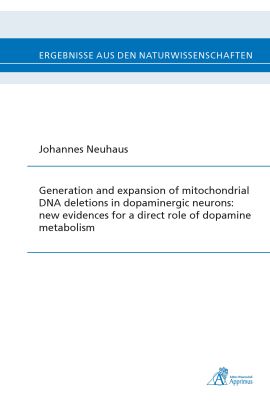Accumulation of mitochondrial DNA (mtDNA) deletions in single cells is commonly observed
in many tissues during normal ageing and age-related pathologies. One striking example are
dopaminergic neurons of the substantia nigra pars compacta (SNc), which accumulate
mtDNA deletions to levels compromising cell survival. Since loss of these neurons is a
pathological hallmark of Parkinson’s disease (PD), and increased loads of mtDNA deletions
have been found in PD patients, their causative role in this pathology was postulated. Also, it
is still unclear why other dopaminergic neuron populations, such as those from the ventral
tegmental area (VTA), are spared from death. Additionally, the molecular mechanisms
involved in the generation and/or expansion of mtDNA deletions over time have not yet been
elucidated.
Through combined in vitro and in vivo approaches dopamine metabolism was identified as a
major contributor to mtDNA deletion accumulation in dopaminergic neurons. Indeed, as in
humans, age-related accumulation of mtDNA deletions was more prominent in the SNc of
mice. Also, neuromelanin can be excluded as being causative, since mouse nigral neurons
are devoid of the black pigment. Further in vitro experiments in dopaminergic neuron-like
human SH-SY5Y cells support the detrimental role of dopamine on mtDNA integrity. Direct
dopamine treatment or enhanced dopamine metabolism after overexpression of key
enzymes both induced mtDNA deletions in terminally differentiated cells. Moreover, inhibiting
the uptake of dopamine attenuated its deleterious effect. The newly generated mtDNA
deletions were spanning the whole genome, with the exception of indispensable regulatory
regions, and were similar to those observed in humans. The mechanisms leading to mtDNA
deletions are likely to involve single- and double-strand breaks, as suggested by southernblot
analysis. However, the selective vulnerability of SNc neurons cannot be explained by the
presence of mtDNA deletions alone, since single dopaminergic neurons of the VTA were
found to harbour the same load of mtDNA deletions.
In conclusion, the accumulation of mtDNA deletions in dopaminergic neurons is driven by
dopamine, probably through continuous de novo generation caused by strand-break repair.
Even though their exact impact on the selective neurodegeneration in PD has still to be
clarified, mtDNA deletions are certainly acting in combination with other SNc neuron-specific
factors, ultimately leading to cell death.
| Autor | Neuhaus, Johannes |
|---|---|
| Lieferzeit | 3-4 Tage |
| Gewicht | 0.3 kg |
| Erscheinungsdatum | 14.06.2013 |
Eigene Bewertung schreiben
Ergebnisse aus den Naturwissenschaften
Generation and expansion of mitochondrial DNA deletions in dopaminergic neurons: new evidences for a direct role of dopamine metabolism
ISBN: 978-3-86359-134-2
39,00 €
inkl. 7% MwSt.
Kurzbeschreibung
High levels of mitochondrial DNA deletions have been found in dopaminergic neurons of Parkinson Disease patients, suggesting a role in the pathology. However, the reason for this accumulation of mtDNA deletions is unclear. In this work, dopamine was found to drive this phenomenon, probably through forcing continuous DNA strand-break repair events. The results also suggest that mtDNA deletions are acting in combination with other cell-specific factors, to promote neurodegeneration.
Auf Lager

